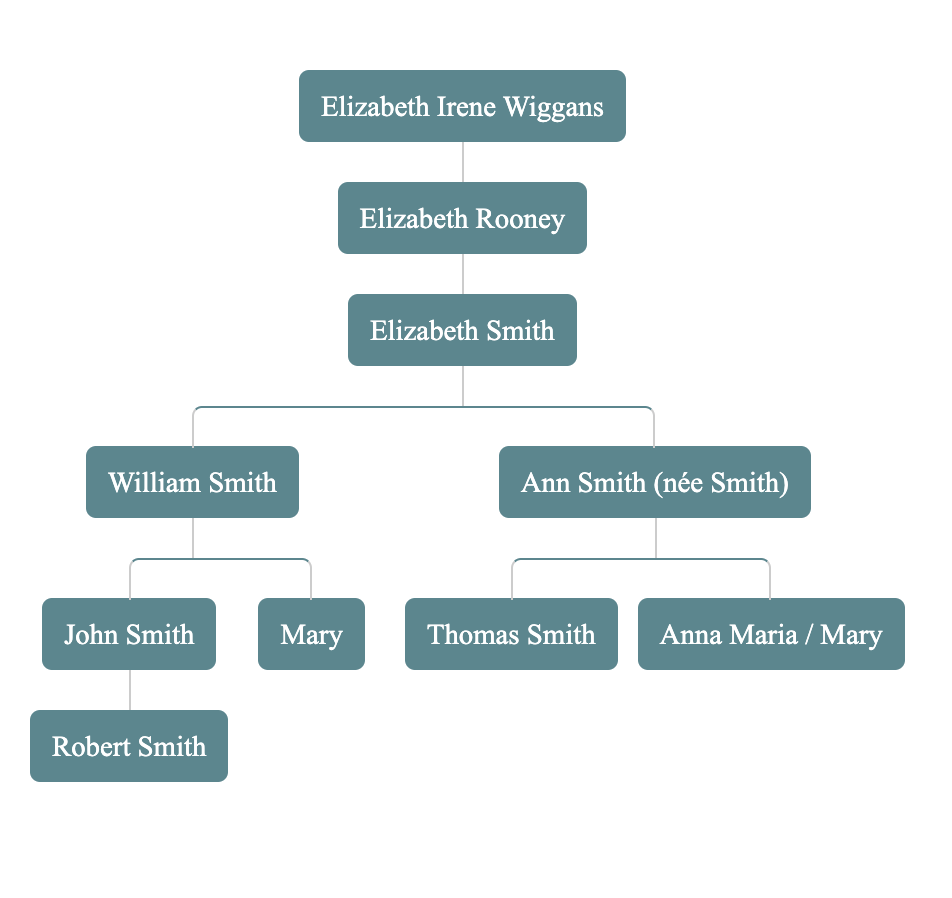Elizabeth Smith, my 2nd great-grandmother, was born in 1849 in Charnock Richard to William and Ann Smith. She was their second child.
Her mother Ann was born in Euxton on March 9th, 1823 to Mary and John Smith and she was baptized on March 10th at Euxton Hall Chapel. Her sponsors, also likely her grandparents, were Mary and Thomas Smith, who are now buried in the churchyard at St. Mary’s in Euxton.

Catholic Euxton
If you are not impressed that we have this information about Ann, you should be. The fact that any English Catholic records survive is a miracle because, in a country where being a Catholic could get you executed, record keeping was dangerous. Roman Catholic worship was only able to continue in Euxton after the Reformation because of the Anderton family – diehard Roman Catholics and the local landowners of Euxton Hall.
Catholic penal laws were first established during the reign of Henry VIII and Elizabeth I, and though they were reformed over time between 1778-1869, Ann and William were born into a world where a Catholic still could not vote; could not hold public office; where priests could not wear clerical garb in public; where monastic orders, steeples and bells were forbidden; where Catholic teachers, priests, schools and churches all had to be registered and monitored. It had only been legal to practice the Catholic faith – in a limited way – for about 30 years.
Ann’s family records 3 English Catholic generations prior to Catholic Emancipation, so it is more than likely – almost certain – that the family resisted Reformation and never converted at all. For that reason, we know almost nothing about them.

Ann & William Smith
Ann was a servant when she married, and the daughter of a farmer. William was a farmer’s servant, born in Wheelton, but living in Heskin at the time of his marriage. His father, Robert, was also farmer. Their marriage on February 4th, 1846 was witnessed by Thomas and Ann Worthington. Ann would have been about 23, William just 20 or 21.
The marriage certificate records the location as St. Gregory’s Chapel (top line) and Weld Bank Chapel (lower line) but this is one and the same place. It was established in the 1740’s in a barn at Weld Bank, after Burgh Hall and it’s Chapel – owned by the Catholic Chadwick family – was burned to the ground. By 1814, when the current building was built, it was known as ‘Weld Bank’ as much as ‘St Gregory’s’, and they were married there by Father Lawrence O’Toole.
Bolton Green
In 1851, William and Ann Smith were living at Bolton Green Farm – which remarkably still stands. It has a farmhouse and a barn, both Grade II listed buildings, dating from the 17th century, with sandstone walls and slate rooves. They may have lived in the servants quarters, but more likely lived elsewhere on the property.
Robert, their eldest son, was born in Euxton in 1847. But by 1849, when Elizabeth was born, they were in Charnock Richard on Bolton Green, and they stayed there through the birth of 3 more children: John, 1851; Mary, 1853; Jane, 1855. Their 6th child, Henry, was born in Adlington in 1858, and the last 3 children – all sons – were born in Chorley: Thomas, 1859; James, 1863; and George, 1865.
We don’t know what took the family to Adlington in 1858. Maybe it was a good place for a farmer’s servant to seek work. Whatever the reason, they didn’t stay long and by 1859 they were on Back Mount Street in the heart of downtown Chorley. Their oldest Robert was in his early teens and already working as a cotton weaver. William was then working as a ‘carter’, the 19th century equivalent of a trucker or delivery man. He literally carted things from place to place for a living.

Morris Fold Farm
William must have been an industrious sort because by 1871 he’d cobbled together enough money to farm his own 12 acres at 9 Morris Fold Farm, off Eaves Lane. He probably did not own the land – 90% of farmland in England was tenanted in the 19th century – but he might have owned the right to lease it. On the other hand, a contemporary newspaper account of a trespass on that land calls William Smith the “owner”.
Rural England had a 3 tier structure: landowners – almost always nobility, gentry or yeoman – tenant farmers, and farmworkers. To make a transition from farmer’s servant to tenant farmer was a working man’s dream, to jump to ownership would be amazing. A deed search on Morris Fold – less straightforward than it sounds – could tell us the truth of it.
But starting at least by 1871, the family was finally working for itself. All of William’s children except the youngest list their occupation as “farmer’s son” or “farmer’s daughter”. By 1881, they had increased their holdings to 26 acres. When we last see William in 1891, he was still living on Morris Fold Farm at the age of 65. His son George is on the property in a nearby cottage, but only his wife, their grown daughter Jane, and a boarder named Mary Smith from Croston are still living with him.
William, a retired farmer, died of enteritis and chronic bronchitis at the age of 74 on May 1st, 1902 at Finney Lane in Euxton, as certified by his son Henry of 227 Lyons Lane, Chorley.
We know that Elizabeth Smith was gone from Morris Fold by 1874, when she married John Rooney. We don’t know how they met but it is possible he worked at Morris Fold as a farm labourer. Her brother Robert traveled to Fleetwood for her wedding. After John died, Elizabeth remarried to John Marsden in 1905, and died herself in Chorley about 1910.

